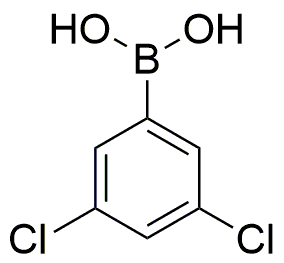3,5-Dichlorophenylboronic acid is widely utilized in research focused on:
- Synthesis of Pharmaceuticals: This compound plays a crucial role in the development of various drugs, particularly in the synthesis of anti-cancer agents. Its ability to form stable complexes with certain biomolecules enhances drug efficacy.
- Organic Synthesis: It is commonly used in Suzuki coupling reactions, which are essential for creating complex organic molecules. This application is vital in the production of agrochemicals and fine chemicals.
- Bioconjugation: The compound is employed in bioconjugation processes, allowing researchers to attach biomolecules to surfaces or other molecules, which is beneficial in diagnostics and therapeutic applications.
- Sensor Development: Its unique properties make it suitable for developing sensors that detect specific biomolecules, aiding in environmental monitoring and medical diagnostics.
- Material Science: In material science, it is used to modify polymers, improving their properties for applications in coatings, adhesives, and electronic materials.
General Information
Properties
Safety and Regulations
Applications
3,5-Dichlorophenylboronic acid is widely utilized in research focused on:
- Synthesis of Pharmaceuticals: This compound plays a crucial role in the development of various drugs, particularly in the synthesis of anti-cancer agents. Its ability to form stable complexes with certain biomolecules enhances drug efficacy.
- Organic Synthesis: It is commonly used in Suzuki coupling reactions, which are essential for creating complex organic molecules. This application is vital in the production of agrochemicals and fine chemicals.
- Bioconjugation: The compound is employed in bioconjugation processes, allowing researchers to attach biomolecules to surfaces or other molecules, which is beneficial in diagnostics and therapeutic applications.
- Sensor Development: Its unique properties make it suitable for developing sensors that detect specific biomolecules, aiding in environmental monitoring and medical diagnostics.
- Material Science: In material science, it is used to modify polymers, improving their properties for applications in coatings, adhesives, and electronic materials.
Documents
Safety Data Sheets (SDS)
The SDS provides comprehensive safety information on handling, storage, and disposal of the product.
Product Specification (PS)
The PS provides a comprehensive breakdown of the product’s properties, including chemical composition, physical state, purity, and storage requirements. It also details acceptable quality ranges and the product's intended applications.
Certificates of Analysis (COA)
Search for Certificates of Analysis (COA) by entering the products Lot Number. Lot and Batch Numbers can be found on a product’s label following the words ‘Lot’ or ‘Batch’.
Numéro de catalogue
Numéro de lot/série
Certificates Of Origin (COO)
This COO confirms the country where the product was manufactured, and also details the materials and components used in it and whether it is derived from natural, synthetic, or other specific sources. This certificate may be required for customs, trade, and regulatory compliance.
Numéro de catalogue
Numéro de lot/série
Safety Data Sheets (SDS)
The SDS provides comprehensive safety information on handling, storage, and disposal of the product.
DownloadProduct Specification (PS)
The PS provides a comprehensive breakdown of the product’s properties, including chemical composition, physical state, purity, and storage requirements. It also details acceptable quality ranges and the product's intended applications.
DownloadCertificates of Analysis (COA)
Search for Certificates of Analysis (COA) by entering the products Lot Number. Lot and Batch Numbers can be found on a product’s label following the words ‘Lot’ or ‘Batch’.
Numéro de catalogue
Numéro de lot/série
Certificates Of Origin (COO)
This COO confirms the country where the product was manufactured, and also details the materials and components used in it and whether it is derived from natural, synthetic, or other specific sources. This certificate may be required for customs, trade, and regulatory compliance.


